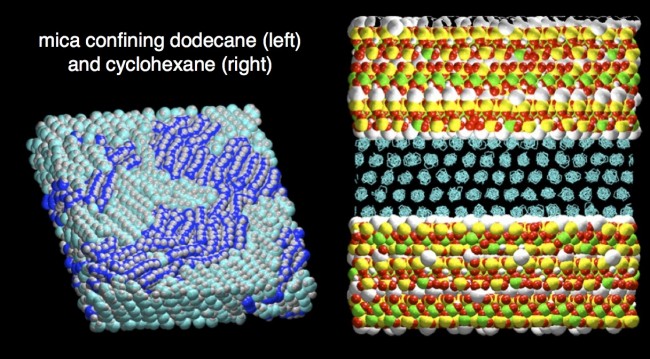Cummings Group: Molecular Simulation of Nanoconfined fluids
Simulation and free energy calculations of nanoconfined fluids
Nanoconfined fluids play a crucial role in many natural and man-made products and processes, including adsorption, lubrication, and more recently, ionic-liquid supercapacitors. Nanoconfinement can induce significant changes to the structural and dynamical behavior of systems, e.g., inducing the formation of solid phases when equivalent bulk systems would remain fluid. Given that a lubrication is a key application area of nanoconfinement fluids, understanding how the phase behavior is shifted as compared to bulk, is essential for designing next generation lubricants.
The Cummings group uses a multifaceted approach to examining nanoconfined systems, including molecular dynamics simulations with fully atomistic, reactive atomistic, and coarse-grained models. In addition to standard molecular dynamics approaches, free energy methods are also employed to better understand the phase behavior, including the Einstein crystal method and, in conjunction with the McCabe group, the statistical temperature molecular dynamics (STMD) method.
Selected Related Publications:
- Wan L, Iacovella CR, Nguyen T, Docherty H, Cummings PT (2012) Confined fluid and the fluid-solid transition: The evidence from free energy calculations, Physical Review B, 86, pp 214105
– DOI:10.1103/PhysRevB.86.214105
- Cummings PT, Docherty H, Iacovella CR, Singh JK (2010) Phase transitions in nanoconfined fluids: The evidence from simulation and theory (Perspective), AICHE Journal, 56, pp 842–848
– DOI:10.1002/aic.12226
- Docherty H, Cummings PT (2010) Direct evidence for fluid–solid transition of nanoconfined fluids, Soft Matter, 6, pp 1640-1643
– DOI:10.1039/C000821D


Connect with Vanderbilt
©2024 Vanderbilt University ·
Site Development: University Web Communications